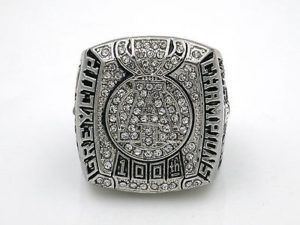
2012 Grey Cup – Toronto Argonauts vs Calgary Stampeders
The 100th Grey Cup was a Canadian football game between the East Division champion Toronto Argonauts and the West Division champion Calgary Stampeders of the Canadian Football League to decide the Grey Cup champions of the 2012 season.
The game took place on Sunday, November 25, 2012, at Rogers Centre in Toronto, Ontario. This was the fourth Grey Cup game played at Rogers Centre, and the 46th in the city of Toronto.
The Argonauts defeated the Stampeders 35–22 to win their sixteenth Grey Cup title.
This was the third meeting between Calgary and Toronto for the Grey Cup championship and the first since the 79th Grey Cup in 1991. This was also the second consecutive year that the Grey Cup game involved, and was won by, the team from the host city. The result of the game also meant that Argonauts owner David Braley became the first team owner to win back-to-back Grey Cups with two different teams; Braley also owns the 2011 champions, the BC Lions. Over 5.8 million viewers watched the game, with roughly 5.5 million originating from English Canada, making the game the most-watched Grey Cup ever recorded on English-language television.
Following the game, Toronto running back Chad Kackert was named the Most Valuable Player. His teammate, defensive end Ricky Foley received the Dick Suderman Trophy as the Most Valuable Canadian.
100th Grey Cup celebrations
The league promoted the 100th Grey Cup in several ways. The Grey Cup 100 Train Tour, with three CFL-themed railway coaches, criss-crossed Canada for ten weeks. Starting September 9 at Pacific Central Station in Vancouver, the Grey Cup was placed on board the train during an official ceremony. The coaches traveled east across Canada, visiting over 100 communities including all eight CFL cities as well as Ottawa, Quebec City, Moncton, and Halifax. It also made stops in Nunavut and Newfoundland and Labrador. The train arrived in Toronto on November 17, 2012. It featured a museum car, a railcar with contemporary memorabilia, and a car containing the Grey Cup itself.
Canada Post celebrated the 100th Grey Cup by issuing a series of commemorative postage stamps, designed by Bensimon Byrne of Toronto. Stamps have been produced for each team; every franchise chose one player in its history to be on the foreground of their team’s stamp and the background features a historical moment from a past Grey Cup.
In the week leading up to the game, the Canadian government recognized the historical significance of the Grey Cup at a ceremony at Varsity Stadium in Toronto, which hosted the Grey Cup game twenty-nine times between 1909 and 1957. Because of this recognition the Grey Cup will be placed in Canada’s system of national historic sites, persons and events.
On November 22, the Queen of Canada, Elizabeth II, issued a message recognizing the hundredth edition of the game, as well as the 48th edition of the Vanier Cup, which was played two days prior to the Grey Cup. In her message, the Queen noted the monarchical ties of both championships and wished an enjoyable weekend for the teams, players and fans.
Game Summary
Calgary, being the designated away team, made the call of heads for the coin toss; the result was a tails, allowing Toronto to choose to receive the ball for the first half of the game. The roof of the Rogers Centre was closed for the entirety of the game.
On Toronto’s first offensive play of the game, quarterback Ricky Ray was intercepted by Quincy Butler. It was Ray’s first interception since October 27. However, Calgary was unable to capitalize on the turnover and was forced to punt the football to end their first drive. Calgary committed their first turnover of the game on their next possession when running back Jon Cornish fumbled the ball on a handoff from quarterback Kevin Glenn. Toronto ended up opening up the scoring on the ensuing drive thanks to a five-yard touchdown run by the league’s Most Outstanding Player Chad Owens.
The Stampeders responded to the touchdown with a field goal by Rene Paredes to cut the score down to 7–3 and they quickly regained possession of the ball, but the drive was cut short when Glenn was picked off by Toronto cornerback Pacino Horne, who ran the ball in for a touchdown to put the Argos up 14–3 early in the second quarter. On their following possession, Toronto found themselves at Calgary’s 12-yard line following a 62-yard pass from Ray to Jason Barnes, but were forced to settle for a field goal by the Stampeders defence. Calgary responded with a field goal of their own to reduce the Argo lead to 17–6. Toronto would add another touchdown before halftime on a one-yard touchdown catch by Dontrelle Inman from Jarious Jackson.
Having received the ball at the start of the second half, Calgary moved the ball from their own 10-yard line to scoring range thanks to a 15-yard pass from Glenn to slotback Marquay McDaniel and a Toronto pass interference penalty. However, the Toronto defence again forced the Stampeders to kick a field goal, cutting the score to 24–9. Following a Toronto touchdown midway through the third quarter, Calgary’s Larry Taylor ran the ensuing kickoff 105 yards for an apparent touchdown, however the play was called back around midfield due to a holding penalty called against Keon Raymond. The penalty negated the score, and the Stampeders were again unable to overcome the Argonauts defence, punting the ball. On their next drive, the Stampeders were unable to capitalize despite a penalty to Toronto player Adriano Belli, who received a disqualification after an altercation with Calgary defensive lineman Jon Gott; Calgary was forced to punt the ball, but was able to force Toronto to concede a safety three plays later to end the third quarter.
The fourth quarter opened promisingly for Calgary. On a second-and-long play by the Stampeders, a pass interference penalty was called on Argos defensive back Ahmad Carroll to put them in scoring range. However, the Argonauts defence again prevented the Stampeders from reaching the end zone and Calgary settled for their fourth field goal of the game. With 5:56 left in the game, Ricky Ray threw his second touchdown pass of the night to put the Argos up 34–14. Stampeders receiver Maurice Price scored his team’s lone touchdown of the game with twenty seconds remaining on the clock and followed up with the two-point conversion. After a failed onside kick, Toronto allowed the clock run down, winning the game by a final score of 35–22.
Toronto’s Chad Kackert was named the Most Valuable Player of the Grey Cup after rushing the ball 20 times for 133 yards and adding 62 yards from 8 pass receptions. Defensive end Ricky Foley, a native of Courtice, Ontario, won the Dick Suderman Trophy as the game’s top Canadian player after recovering a Calgary fumble early in the game and for helping to limit Calgary’s Cornish to 57 yards rushing for the game.
Game Highlights
Scoring Summary
 First Quarter
First Quarter
TOR – TD Owens 5 yd pass from Ray (Waters convert) (7:32) 7 – 0 TOR
CGY – FG Paredes 40 (4:09) 7 – 3 TOR
Second Quarter
TOR – TD Horne 25 yd interception return (Waters convert) (14:46) 14 – 3 TOR
TOR – FG Waters 16 (9:25) 17 – 3 TOR
CGY – FG Paredes 18 (2:33) 17 – 6 TOR
TOR – TD Inman 1 yd pass from Jackson (Waters convert) (0:22) 24 – 6 TOR
Third Quarter
CGY – FG Paredes 27 (6:29) 24 – 9 TOR
TOR – FG Waters 30 (3:01) 27 – 9 TOR
CGY – Safety (0:04) 27 – 11 TOR
Fourth Quarter
CGY – FG Paredes 19 (9:58) 27 – 14 TOR
TOR – TD Durie 7 yd pass from Ray (Waters convert) (5:56) 34 – 14 TOR
TOR – Single Prefontaine 53 yd punt (1:42) 35 – 14 TOR
CGY – TD Price 12 yd pass from Mitchell (Price 2-pt convert) (0:20) 35 – 22 TOR
Entertainment
The CFL unveiled an “all-Canadian, all-star lineup” of musical acts to perform the pre-game and halftime shows at the game. Burton Cummings, former lead singer of 1960s–1970s rock band The Guess Who, performed “O Canada”, and country artist Johnny Reid performed as part of the pre-game show. The halftime show featured pop artists Justin Bieber and Carly Rae Jepsen, along with rock band Marianas Trench and balladeer Gordon Lightfoot. CFL commissioner Mark Cohon explained that the lineup was “quintessentially Canadian and undoubtedly world class”, spanned multiple generations of music, and would “command a huge and diverse audience, entertaining our most loyal fans and attracting new ones to our game’s greatest showcase.”

